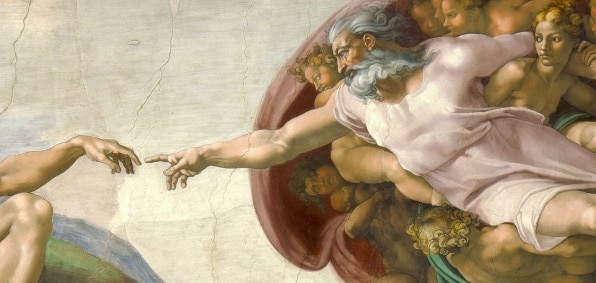HHA | 11/9/2014
WND | 11/9/2014
NEW YORK – The “DaVinci Code” that formed the central mystery in Dan Brown’s mega-bestselling 2003 novel of the same name is built on the premise that Leonardo DaVinci hid a theological mystery in his famous 15th-century mural of the Last Supper
In a similar fashion, a theory has developed that Michelangelo embedded the face in the Shroud of Turin in his Last Judgment fresco on the altar wall of the Sistine Chapel in Vatican City.
Former FBI forensic specialist Philip E. Dayvault first proposed the idea in a paper he published in 2012 while working in North Carolina as an investigative researcher.
What has become known as the “Dayvault Hypothesis” is the theory that the Last Judgment fresco and a portion of the ceiling fresco by Michelangelo in the Sistine Chapel contain the “hidden in plain view” image of the face of the man in the Shroud of Turin, traditionally revered by many Christians as the actual burial cloth of Jesus Christ.
In October, the theory gained new energy with the publication on Academia.edu by Belgian theoretical chemist Jan Verhulst, Ph.D., of a paper titled “The Embedment of the Face on the Shroud of Turin in Michelangelo’s Last Judgment: A corroboration of the Dayvault hypothesis.”
The correspondence is seen by viewing the eyes – in Latin, the occuli – of the face of the man in the Shroud of Turin as formed by the two half-circle spaces that merge the top of the altar wall in the Sistine Chapel with the ceiling.
The core group of figures in Michelangelo’s painting – corresponding to the nose of the face of the man in the Shroud of Turin – are Christ and his mother, Saint Lawrence seen with the grill on which he was roasted to death, and Saint Bartholomew holding the skin that was removed from his body in the passion of his martyrdom.
Verhulst’s recently published paper and the accompanied note make the comparison:
Verhulst references Pietro Aretino, a contemporary biographer of Michelangelo, who observed, “Michelangelo has imitated those great philosophers who hid the mysteries of human and divine philosophy under a veil, that they might not be understood by the vulgar,” concluding Michelangelo embedded “secret content” in his artwork.
“The researcher is struck by a certain shape or gestalt that seems to be embedded in the painting,” Verhulst wrote, acknowledging that errors of wishful thinking and “a posteriori interpretation of the data” can easily mislead an investigator into seeing in a painting whatever image the investigator wants to see.
In an attempt to test scientifically the hypothesis that “Michelangelo’s Last Judgment could have been framed using as a template the face on the Turin Shroud,” Verhulst measured prominent features on the face. The features included pronounced injuries he was able to map precisely onto measurements of prominent features in the Michelangelo fresco.
Verhulst’s conclusion is that Michelangelo used the Shroud of Turin as a template for his Last Judgment.
“Michelangelo encoded in his painting a lot of elements derived from the Turin Stroud, from its image and from its fabric,” Verhulst wrote.
“There can be little doubt that Michelangelo considered the Shroud of Turin to be the authentic burial cloth of Jesus. And clearly, he had access to very extensive knowledge of this object,” Verhulst said.
“The fact that Michelangelo used the Shroud of Turin as a template for the fresco, and as a hidden source for a great many pictorial details, constitutes an important example of the exoteric dimension in Christian art.”
Verhulst continued with an attempt to explain the hidden message he believes Michelangelo sought to convey.
“The decision to use the Shroud of Turin as a hidden source for structuring he fresco was not Michelangelo’s whim,” Verhulst argued.
“He used the shroud because of what he believed was the essence of the Last Judgment. In his view, at the Last Judgment, every human being will look back at the passion of Christ, so to say as seen through the eyes of Christ himself. And looking back in this way, every single human entity will become its own final judge.”
Verhulst concluded: “No doubt, Michelangelo considered the Shroud of Turin a striking remnant of this passion of Christ, that in his view will be at the heart of the Last Judgment. Therefore, it was logical for him to use the face on the Shroud as a template and as a source of inspiration for his painting.”
One difficulty with the theory is that there is no evidence in two contemporary biographies of Michelangelo or in the records of his personal letters that he had ever seen the shroud. It was, however, exhibited in his lifetime in northern Italy — in Turin, Milan, Vercelli and Nice.
Shroud expert Ian Wilson of Brisbane also wrote Dayvault, saying that “in all of [Michelangelo’s] drawings and writings, there’s not a hint that I have ever come across of his interest in, or awareness of, the shroud.”
An issue that concerned Dayvault was that the features of the face of the man in the Turin Shroud were only seen in negative form until a photograph by Seconda Pia in 1898 gave a clearer rendition of the image.
Dayvault concluded Michelangelo encoded into the fresco the traditional image of Christ’s face used by artists since the first century, which he believes was derived ultimately from the shroud itself.
Thus, Dayvault concluded Michelangelo “unknowingly” painted the encoded image of the shroud in the structure of the Last Judgment fresco, because he had in mind the traditional image of Christ.
In 2002, when conducting ancient oil lamp research in museum depots in Turkey, Dayvault discovered an ancient mosaic that depicted the face of Christ in an image he traced through various Christological depictions. They included paintings, frescoes, mosaics and icons that he determined trace back to an early first century image of Christ’s face known as the “Image of Edessa,” or the Keramion, which bears a remarkable correspondence to the face of the man in the shroud.
In a 2011 paper titled “Face of the God-man: A Quest for Ancient Oil Lamps Leads to the Prototype of Sacred Art … and MORE!” Dayvault argued the ancient mosaic he found was further evidence the Shroud of Turin had been seen by religious artists very close to the time of Christ, providing what he interpreted as a reason to conclude the Shroud of Turin was not the creation of a medieval artist.
While Dayvault may have been the first to suggest the Shroud of Turin was embedded into Michelangelo’s Last Judgment, there is a tradition of art historians who see the fresco as built around the outline of a face.
“The vaulting of the chapel shapes the eyes and eyebrows,” wrote physiologist Sue Brinkley Tatem, Ph.D., in her 1997 book “Biological Clocks: Your Owner’s Manual.”
She explained her vision as follows: “The eyes, nose, and mouth regions are lapis lazuli blue, as if one were inside the skull looking out at the blue sky. If one imagines the Sistine Chapel as a sculpture of a skull, and I think that Michelangelo the sculptor did just that, then what he painted is the ‘pineal gland’ view (sometimes called the third eye) – people naked as jaybirds trumpeting in the hole that would be the mouth.”
Read more at http://www.wnd.com/2014/11/the-michelangelo-code-researcher-unlocks-mystery/#2R3wPiSP3FgpMBFK.99














